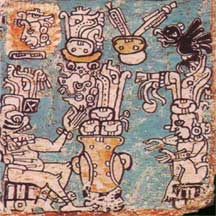
 |
MAYA HIEROGLYPHIC WRITING The Ancient Maya Codices |
|
| THE MADRID CODEX
The Madrid Codex was separated into two parts very early on in its European history, and thus traveled different paths in Europe until 1888. In 1880, the Frenchman Léon de Rosny figured out that the two parts were a single codex, now commonly called the "Madrid", or the "Tro-Cortesianus". The two parts had been called the “Troano” (after the first owner, Don Juan Tro y Ortolano, a professor of Spanish palæography) and the “Cortesanius”. The Troano comprises pages 22-56, 78-112 and the Cortesianus pages 1-21, 57-77 of the Madrid. Since pages 77 and 78 were for some reason always upside-down within the codex, page 78 might be thought of as coming before page 77. Both parts were re-united in 1888, and the Madrid Codex is now in the Museo de América, in Madrid, Spain. Pertinent copies and facsimiles include: |
 |
|
|
1. Brasseur de Bourbourg, "Manuscrit Troano", Imprimerie Impériale, Paris, 1869-1870. His chromolithographic rendition of the Troano is included in this work. A very fine rendition, done with painstaking care. 2. Léon de Rosny, "Codex Cortesianus", Libraires de la Société d'Ethnographie, Paris, 1883. Very good black-and-white photos; 85 copies printed. NOTE: We've found that it's faster and easier to view these documents if you download the individual files to your computer and open them locally. To download and save, right click on the file, choose "save as" from the menu, pick a location ( for example "My Documents" ) and click "Save". The PDF files require Adobe Acrobat Reader. To download the latest version, click the Get Acrobat Reader button below. For those with a fast connection, download the complete PDF file: The combined Brasseur de Bourbourg and Léon de Rosny, Madrid Codex (46.5 MB). For those with slower connections download the PDF file in sections: Pages 01 - 21 (8 MB) 3. In 1892, to celebrate 400 years after Columbus' discovery of America, the Museo Arqueológico Nacional of Madrid published a (photo) chromolithographic facsimile of the Cortesianus. This was done under the direction of don Juan de Dios de la Rada y Delgado and don Jeronimo Lopez de Ayala y del Hierro, Vizconde de Palazuelos. This version, of 500 copies, attained a good reputation. A good rendition of this has been made available at: http://www.wayeb.org/download/resources/cortesiano01.pdf. 4. In 1911, William E. Gates had black-and-white photographs of the Madrid produced (Point Loma, California, USA). He had these printed, as a facsimile, in 1933 by The Maya Society, Baltimore, Maryland, USA. I have never seen either the original 1911 photographs or the 1933 publication, but the photo-copy of the 1933 publication that I have received indicates that the pages are about 4/9 of the area of the codex pages. Some of the photos are quite dark. This makes for a relatively unpleasing appearance, but it is quite accurate, and if enough patience is used, can be very helpful. 5. In 1930, the Junta de Relaciones Culturales published a chromolithographic facsimile of the Troano, made by the Matev Artes e Industrias Gráficas, Madrid. I have seen one of the facsimiles; the paper is a bit rough and the color is rather crudely done, which may account for its rather poor reputation, yet the codex as a whole appears to be done fairly accurately. 6. In 1967, the Akademische Druck- u. Verlagsanstalt, of Graz, Austria printed the full Codex Tro-Cortesianus, as a facsimile from color photos, with introduction and summary by Ferdinand Anders. It is remarkably well-done, and became the basis for the version used in the Chiapas book titled "Los Códices Mayas", (Thomas A. Lee, Jr., 1985). The Graz and the Chiapas versions are among the most used renditions of the Madrid today. 7. In 1991, as part of the 1992 Columbus 500-year celebration, the Testimonio Compania Editoriale of Madrid published, with an accompanying volume by Manuel Ballesteros Gaibrois and Miguel Rivera Dorado, a full-color facsimile edition of the Madrid codex. 980 copies were produced for the Spanish market, and 980 for the international market; a total of 1960 copies. It is a very spiffy and beautiful edition, and has recently been sold for $1,500 to $3,000. It is pricey enough not to become one of the frequently used editions.
|
||
|
Text links to all pages at this site are available at the FAMSI INDEX |
||
